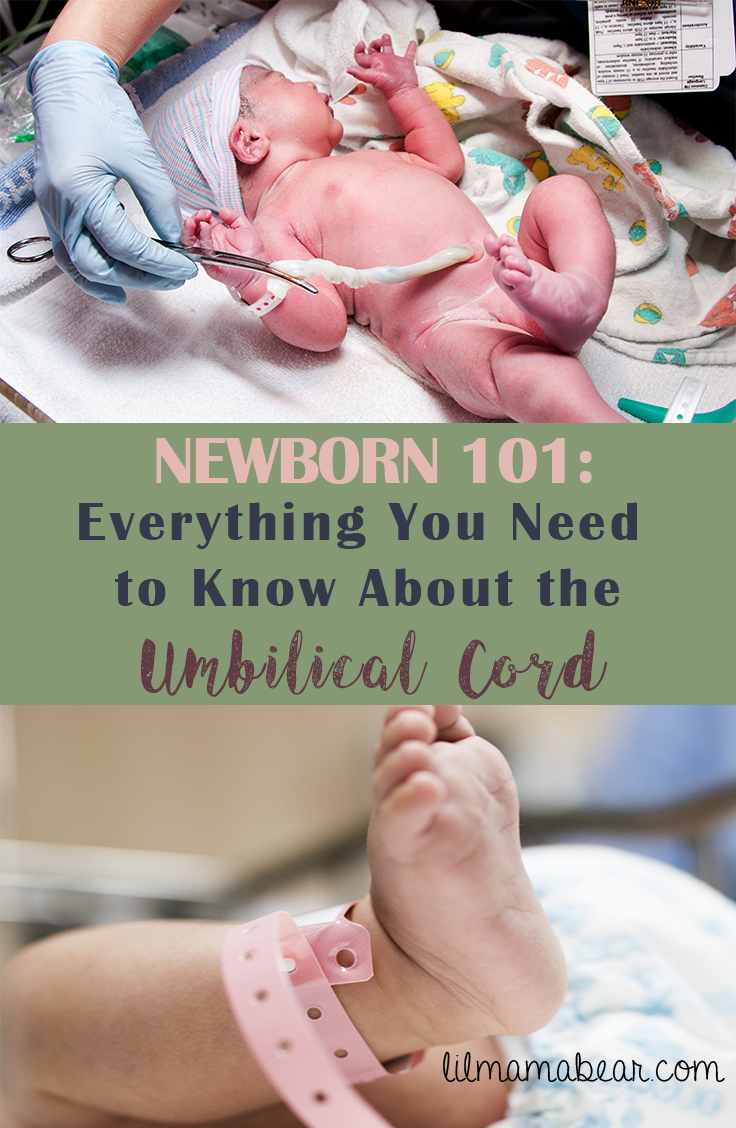
Newborn 101: Everything You Need to Know About the Umbilical Cord
My mom always told me about when I was born and how the umbilical cord was wrapped around my neck. “That doctor saved your life,” she’s said to me many times. Now, whenever I hear the term “umbilical cord”, that story is the first thing that comes to mind.
“Umbilical cord” is one of those terms people toss around when they’re talking about a birth: How sweet it was when your father cut your umbilical cord. We decided to do umbilical cord blood banking.
You think you know what an umbilical cord is and does. It’s the tube that supplies the baby with nutrients while he’s in the womb. Right? In reality, you know nothing of umbilical cords.
I’m exaggerating, of course. You might know simply everything about them and find this entire post a waste of time. BUT if you are like me, you don’t know half as much about umbilical cords as you should.
~
Finally, the pushing and the labor contractions and the excruciating pain were over! One last push and out came our baby Genny. The nurses quickly put her on top of me, and I saw her wrinkley little face. The dimples in her bottom, the vernix smudging her forehead, and that cute button nose we had seen in ultrasound pictures.
And I saw a milk-colored rope-like thing attached to her stomach.
The other end I never saw and never wanted to see.
~
Thus was my first-hand umbilical cord experience.
What is the purpose of the umbilical cord?
As said before, the umbilical cord is the “feeding tube” for your baby in utero. It is connected to the baby through what will become his bellybutton and, on the other end, to the placenta.
During time in the womb, your baby is fed oxygen, nutrients, and eventually antibodiesthrough this 50 cm rope.. Antibodies are proteins that protect from bacterial infections and viruses. Inside the cord are two arteries (used to transport waste and deoxygenated blood out of your baby) and one vein (used to transport oxygen and other good stuff to your baby).
*If you would like to see a picture of a placenta, click here. If not, then don’t. I don’t want to gross everyone out.
Cutting the Cord
Once the baby is born, the cord can be cut to disconnect the baby from the placenta. Although, not all people choose to cut the cord right aware, and some choose not to cut it at all.
When the cord is cut, a medical professional will first clamp a clip onto the cord near the baby’s bellybutton and then clamp another clip near the placenta. Between these two clips is where the cord may be cut (by papa or doctor or whomever would like). The purpose of clamping is to keep blood from spilling out once the cord is cut. Cutting the cord does not hurt your baby because there are no nerve endings in the umbilical cord.
When do you cut the cord?
There are many schools of thought when it comes to cord clamping. When deciding what method to use when dealing with your baby’s umbilical cord, take into consideration our particular child’s situation. If there is a high risk of infant resuscitation, heart issues, or other medical emergencies once your baby is born, these factors must be carefully weighed before making a decision.
Here are some of the most widely practiced umbilical cord procedures:
Delayed Cord Clamping
In the United States, it is generally suggested that cord clamping be delayed for 1-5 minutes (no less than 1 minute, according to WHO guidelines) or as long as possible so that more blood is able to flow from the placenta into the baby. In just 60 seconds, a baby is able to receive 40% more blood than if the cord is immediately cut. Premature babies have less intravascular hemorrhaging (bleeding into the brain’s ventricular system) and less chance of sepsis (serious issue when the body begins fighting itself when fighting off infections) as well as the benefit of additional iron that comes with more red blood cell content. There is a chance of jaundice occurring, but this can easily be treated and usually does not outweigh the effects of having additional iron stores and heightened hemoglobin levels. Only 2% more infants who experienced delayed cord clamping (instead of ICC) needed treatment for jaundice.
When a baby is first born, the umbilical cord is still sending new blood and received deoxygenated blood for about 45 seconds after birth. From that point on, the only transaction happened within the cord is sending blood from the placenta to the baby. When still connected to the placenta, the baby should not be raised over 10 cm from the placenta (coincidentally, the elevation to mama’s chest) until clamping occurs.
Immediate Cord Clamping
This method calls for cord clamping less than 60 seconds after birth. Instances where ICC should be used include if an infant requires a respirator, chest compressions, or blood pressure support immediately after birth. While some also argue this method to decrease postpartum hemorrhaging, the World Health Organization as well as The American Academy of Pediatrics and the American College of Nurse-Midwives deny any direct association between delayed cord clamping and excessive postpartum hemorrhaging.
Another reason why parents might opt for immediate cord clamping despite WHO recommendations is if they are planning to bank cord blood. (More on this later)
Milking the Cord
Also known as “stripping the cord”, this process is achieved by wrapping the fingers around the cord nearest to the placenta and gently squeezing the blood within the cord up towards the baby’s bellybutton. There is less research done on the effects of this method for term babies, but for cesarean and extremely preterm babies, there may be additional benefits. While studies show there to be no change in the effects of cord stripping vs delayed cord clamping for term infants, the added blood pressure caused by milking the cord can improve conditions for preterm and c-section babies.
Lotus Birth
A less traditional method of dealing with the umbilical cord, lotus births allow the cord to detach naturally rather than be cut. After the placenta is delivered, it is placed (still attached) near the baby, who should be in mama’s arms. Many people who choose to have a lotus birth will sprinkle rock salt and rose petals on the placenta to overcome any foul aroma coming from it. During the next 3-15 days of the baby’s life, the placenta is kept in a portable cooler and carried around with the baby until the umbilical cord falls off on its own.
Arguments in favor of the lotus birth claim the method is less traumatic than traditional method of cutting the umbilical cord. Some new mamas claim the lotus birth created a smoother transition into life outside the womb. Despite the lack of research, the lotus birth began in the ’80’s and continues to persist within home-birthing circles. Recently medical professionals have begun to address the fad, but most don’t cast a favorable light on the practice. Because of it’s unorthodox nature, you would need to discuss in length having a lotus birth with your healthcare provider. Many hospitals and birthing centers may not accomodate this, so be sure to do as much research as you can into the subject.
How to Care for the Umbilical Cord Stump
Do not swab the area with alcohol – this old tip has been debunked as healthcare professionals now recommend for parents to instead keep the stump dry. Until the stump falls off, sponge baths do the trick without allowing the area to collect moisture. The umbilical cord stump usually falls off within 1-3 weeks, leaving a cute, kissable belly button! Until that time, it’s best to leave the stump alone in order to avoid infection.
Do call your pediatrician if you think the umbilical cord area may be infected. Signs of infection include swelling, excessive redness in the area, pus buildup, or high fever. Also if your baby’s umbilical cord stump has not fallen off after three weeks, consult your pediatrician.
Does the Umbilical Cord Determine an Innie or an Outie?
If you’ve secretly wondered if this is true, know you aren’t alone! The belly button’s shape forms when the umbilical cord stump creates scar tissue where it connects to the baby. This scar tissue often retracts after the stump falls off, creating an “innie” belly button. Interestingly, only about 10% of individuals have an “outie” belly button. However, the method by which the umbilical cord is clamped and cut has no effect on the resulting shape of the belly button.
So there you have it! Everything you needed to know about the umbilical cord, and more!
Read my post 5 Things You Hear That are NO HELP in the Delivery Room! 5 Things You Hear That are NO HELP in the Delivery Room!
So there you have it! Everything you needed to know about the umbilical cord, and more!
Love, Emily XOXO







Great wealth of detail for those who are expecting. Thanks for the work you put into this information, it’s very important.
Great read! I am going to share this with my friend. She literally just posted a question about the umbilical cord on Facebook a couple of days ago.
I honestly had no idea there were so many options! haha But it really does make a big difference for a newborn. 🙂
I never actually knew what caused an innie or an outie belly button!!! This makes sense as in some people have keloid scarring which is the raised scars instead of normal flat scarring. 🙂
I’ve had people ask me that question of whether the method of cord cutting determines what kind of belly button, but nope! Thanks for reading. 🙂
Wow, thanks for sharing all this information. As a mom of two I knew some things about this, but now I learnt lots of new stuff!
Thanks, Anne! New stuff is always great to learnt 😉
Excellent information! True story: hubs almost cut my poor son’s toes off when he was born because at the last second, my son had wrapped his toes around it! I hollered out and he didn’t but THAT was my first experience with the umbilical cord, lol.
Oh my goodness! Haha Then you have a very interesting umbilical cord story to tell your son
What great information! I know a lot of people never spend time to research the importance of the cord, this post has everything you need to know!
Whoa.. I did not know there was such a thing as a lotus birth. That sounds hard to do having to carry the cooler with the baby for 1-3 weeks! This is such great information! Thanks for sharing! 🙂
Yeah, weird, right? I don’t think I would recommend it to anyone haha
Great post, very informative!
Thanks for reading, Brandy!
Awesome post, very informative! I love the idea of delayed clamping and did it for my youngest. Rose @ Our House of Love
It really is the best way to go if you can. Thanks for reading, Rose-Marie!
this cord is a life-saving cord during pregnancy or during fetus development, parents need to care for them with love and must seek information on how to care for it. all the information that is mention above is really very helpful to understand the importance of the Ambi cord and how to care reading it more than one time will help you to understand deeply about this cord.
Thanks for sharing!